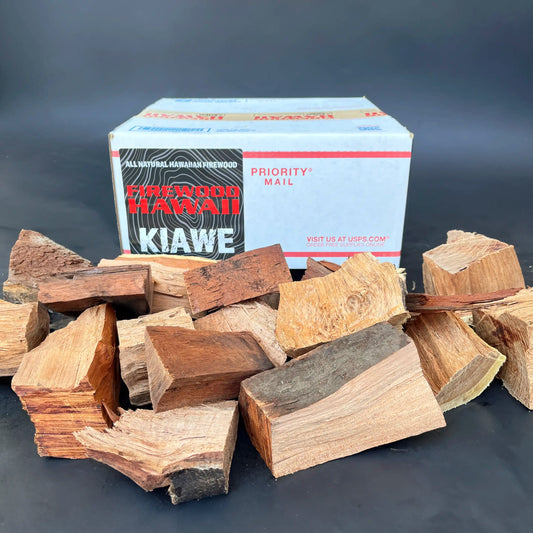
The Complete Guide to Using Wood Chunks on a Charcoal or Gas Grill
Share
Beginner's Guide to Smoking Foods with Wood Chunks
Smoking foods on a grill adds a wonderful depth of flavor and aroma to your culinary creations.
While dedicated smokers are popular, you can achieve fantastic results using wood chunks on a charcoal or gas grill.
In this comprehensive guide, we will walk you through the steps of smoking foods with wood chunks, providing tips and techniques for both charcoal and gas grills.
Get ready to elevate your grilling game and impress your family and friends with deliciously smoked dishes!
Table of Contents:
- Understanding Wood Chunks for Smoking
- Equipment Needed
- Preparing the Grill
- Soaking Wood Chunks
- Preparing the Food
- Setting Up the Grill for Smoking
- Adding Wood Chunks and Generating Smoke
- Monitoring Temperature and Adjustments
- Cooking Time and Food Safety
- Resting and Serving Your Smoked Creations
- Tips and Tricks for Successful Wood Chunk Smoking
- Conclusion
Understanding Wood Chunks for Smoking
Wood chunks are larger pieces of hardwood that provide a steady and prolonged smoke when used for grilling.
Different types of wood chunks offer unique flavors and aromas, so choose the one that complements your desired taste profile.
Firewood Hawaii offers Kiawe, Ironwood, Lychee, Mango, and Strawberry Guava wood.
For this guide, we'll focus on using wood chunks for smoking on charcoal and gas grills.
Equipment Needed
To smoke foods with wood chunks on a charcoal or gas grill, gather the following equipment:
- Charcoal Grill or Gas Grill
- Wood Chunks (preferably high-quality, well-seasoned chunks)
- Charcoal (for charcoal grills)
- Smoker Box or Foil Pouch (for gas grills)
- Meat Thermometer
- Grilling Tongs and Spatula
Preparing the Grill
Clean the grill grates thoroughly to ensure they're free from any residue.
For charcoal grills, arrange the charcoal on one side of the grill, leaving the other side empty for indirect cooking.
Gas grill users should preheat the grill and turn off one or more burners to create an indirect heat zone.
Soaking Wood Chunks
Soaking wood chunks helps them smolder slowly, producing a flavorful smoke. Follow these steps:
- Place the desired amount of wood chunks in a container large enough to accommodate them.
- Fill the container with water, allowing the chunks to fully submerge.
- Soak the wood chunks for at least 30 minutes or up to 1 hour. This step ensures the wood produces smoke instead of burning too quickly.
Preparing the Food
Choose the type of food you want to smoke, such as meat, poultry, fish, or vegetables.
Season the food with dry rubs, marinades, or brines according to your preference.
Allow the food to sit at room temperature for about 30 minutes before grilling.
Setting Up the Grill for Smoking
For charcoal grills:
- Light the charcoal using a chimney starter or any preferred method.
- Once the coals are ashed over, spread them evenly on one side of the grill.
- Place an aluminum foil drip pan filled with water on the empty side to catch drippings and maintain moisture.
For gas grills:
- Preheat the grill to the desired temperature.
- Place a smoker box filled with soaked wood chunks directly over the lit burners or create a foil pouch filled with soaked wood chunks and poke holes in it to release the smoke.
Adding Wood Chunks and Generating Smoke
For charcoal grills:
- Carefully place a few soaked wood chunks directly on the hot charcoal.
- Close the grill lid and adjust the vents to achieve the desired airflow for consistent smoking.
For gas grills:
- Place the smoker box with soaked wood chunks or the foil pouch with holes over the lit burners.
- Close the grill lid to trap the smoke inside.
Monitoring Temperature and Adjustments
- Use a meat thermometer to monitor the temperature of your grill and ensure it stays within the desired range for smoking.
- Adjust the vents on a charcoal grill to regulate the airflow and maintain the temperature.
- For gas grills, adjust the burner settings to control the heat level.
Cooking Time and Food Safety
Follow cooking time and temperature guidelines for the specific food you're smoking.
It's crucial to ensure that the food reaches the appropriate internal temperature for safety.
Use a meat thermometer to check the doneness of the food.
Resting and Serving Your Smoked Creations
Once the food has reached the desired doneness, remove it from the grill using grilling tongs and spatula.
Allow the food to rest for a few minutes before serving.
Resting helps the juices redistribute and the flavors to develop.
Serve your mouthwatering smoked creations and enjoy!
Tips and Tricks for Successful Wood Chunk Smoking
- Experiment with different wood chunk flavors to find your preferred taste profiles.
- Use a water pan in the grill to maintain moisture and prevent the food from drying out.
- Avoid constantly opening the grill lid to maintain a consistent temperature and smoke level.
- Start with smaller batches of wood chunks and gradually increase the amount for stronger smoke flavors.
- Keep a close eye on the grill temperature and make necessary adjustments throughout the smoking process.
Conclusion
Smoking foods with wood chunks on a charcoal or gas grill allows you to enjoy the delicious flavors and aromas of smoked dishes without the need for a dedicated smoker.
By following the steps outlined in this guide, you'll be well on your way to becoming a skilled wood chunk smoker.
So fire up your grill, grab some wood chunks, and get ready to impress your guests with incredible smoked creations!








